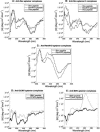Arginine-rich motifs present multiple interfaces for specific binding by RNA
- PMID: 16314457
- PMCID: PMC1370873
- DOI: 10.1261/rna.2167605
Arginine-rich motifs present multiple interfaces for specific binding by RNA
Abstract
A number of proteins containing arginine-rich motifs (ARMs) are known to bind RNA and are involved in regulating RNA processing in viruses and cells. Using automated selection methods we have generated a number of aptamers against ARM peptides from various natural proteins. Aptamers bind tightly to their cognate ARMs, with K(d) values in the nanomolar range, and frequently show no propensity to bind to other ARMs or even to single amino acid variants of the cognate ARM. However, at least some anti-ARM aptamers can cross-recognize a limited set of other ARMs, just as natural RNA-binding sites have been shown to exhibit so-called "chameleonism." We expand upon the number of examples of cross-recognition and, using mutational and circular dichroism (CD) analyses, demonstrate that there are multiple mechanisms by which RNA ligands can cross-recognize ARMs. These studies support a model in which individual arginine residues govern binding to an RNA ligand, and the inherent flexibility of the peptide backbone may make it possible for "semi-specific" recognition of a discrete set of RNAs by a discrete set of ARM peptides and proteins.
Figures


References
-
- Austin, R.J., Xia, T., Ren, J., Takahashi, T.T., and Roberts, R.W. 2002. Designed arginine-rich RNA-binding peptides with picomolar affinity. J. Am. Chem. Soc. 124: 10966–10967. - PubMed
-
- Battiste, J.L., Mao, H., Rao, N.S., Tan, R., Muhandiram, D.R., Kay, L.E., Frankel, A.D., and Williamson, J.R. 1996. Alpha helix-RNA major groove recognition in an HIV-1 rev peptide-RRE RNA complex. Science 273: 1547–1551. - PubMed
-
- Berova, N., Nakanishi, K., and Woody, R. 2000. Circular dichroism: Principles and applications. Wiley, New York.
Publication types
MeSH terms
Substances
LinkOut - more resources
Full Text Sources
Other Literature Sources
